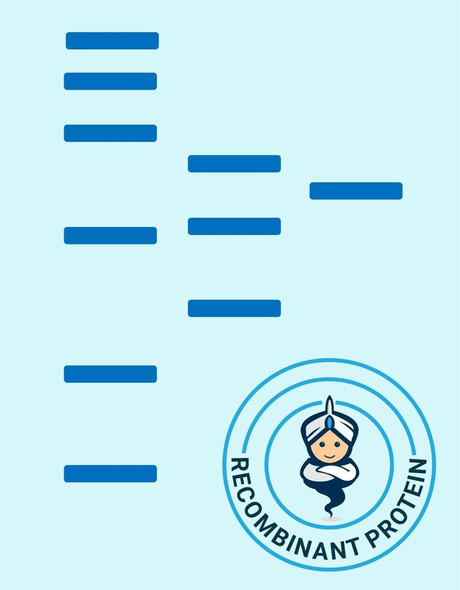Human PIR Recombinant Protein (RPPB4252)
- SKU:
- RPPB4252
- Product type:
- Recombinant Protein
- Size:
- 25ug
- Species:
- Human
- Target:
- PIR
- Synonyms:
- Pirin
- Probable quercetin 2
- 3-dioxygenase PIR
- Probable quercetinase
- Source:
- Escherichia Coli
- Uniprot:
- O00625
Description
| Product Name: | Human PIR Recombinant Protein |
| Product Code: | RPPB4252 |
| Size: | 25µg |
| Species: | Human |
| Target: | PIR |
| Synonyms: | Pirin, Probable quercetin 2,3-dioxygenase PIR, Probable quercetinase, PIR. |
| Source: | Escherichia Coli |
| Physical Appearance: | Sterile Filtered clear solution. |
| Formulation: | PIR protein solution (1mg/ml) containing 20mM Tris-HCl buffer (pH8.0), 20% glycerol, 0.1M NaCl and 1mM DTT. |
| Stability: | Store at 4°C if entire vial will be used within 2-4 weeks. Store, frozen at -20°C for longer periods of time. For long term storage it is recommended to add a carrier protein (0.1% HSA or BSA).Avoid multiple freeze-thaw cycles. |
| Purity: | Greater than 95.0% as determined by SDS-PAGE. |
| Amino Acid Sequence: | MGSSHHHHHH SSGLVPRGSH MGSSKKVTLS VLSREQSEGV GARVRRSIGR PELKNLDPFL LFDEFKGGRP GGFPDHPHRG FETVSYLLEG GSMAHEDFCG HTGKMNPGDL QWMTAGRGIL HAEMPCSEEP AHGLQLWVNL RSSEKMVEPQ YQELKSEEIP KPSKDGVTVA VISGEALGIK SKVYTRTPTL YLDFKLDPGA KHSQPIPKGW TSFIYTISGD VYIGPDDAQQ KIEPHHTAVL GEGDSVQVEN KDPKRSHFVL IAGEPLREPV IQHGPFVMNT NEEISQAILD FRNAKNGFER AKTWKSKIGN |
Pirin (PIR) which belongs to the cupin superfamily, is an Fe(II)-containing nuclear protein expressed in all tissues of the body and concentrated within dot-like subnuclear structures. Pirin may function as a transcriptional cofactor and is involved in the regulation of DNA transcription and replication, as a result of interactions with nuclear factor I/CCAAT box transcription factor as well as B cell lymphoma 3-encoded oncoprotein.
PIR Human Recombinant produced in E.Coli is a single, non-glycosylated polypeptide chain containing 310 amino acids (1-290 a.a.) and having a molecular mass of 34.3kDa.PIR is fused to a 20 amino acid His-tag at N-terminus & purified by proprietary chromatographic techniques.
| UniProt Protein Function: | PIR: Possible transcriptional coregulator. May contribute to the regulation of cellular processes via its interaction with BCL3. May be required for efficient terminal myeloid maturation of hematopoietic cells. May play a role in the regulation of cell migration. May promote apoptosis when overexpressed. Has quercetin 2,3-dioxygenase activity (in vitro). May interact with NF1/CTF1. Interacts with BCL3. Identified in a complex comprised of PIR, BLC3, NFKB1 and target DNA. Up-regulated in CD34(+) cells upon myelomonocytic differentiation. Down-regulated in many acute myeloid leukemias. Up-regulated in primary bronchial epithelial cells exposed to cigarette smoke extract. Highly expressed in a subset of melanomas. Detected at very low levels in most tissues. Expressed in all tissues, with highest level of expression in heart and liver. Inhibited by kojic acid, sodium diethyldithiocarbamate and 1,10-phenanthroline monohydrochloride. Belongs to the pirin family. |
| UniProt Protein Details: | Protein type:EC 1.13.11.24; Oxidoreductase; Transcription, coactivator/corepressor Chromosomal Location of Human Ortholog: Xp22.2 Cellular Component: cytoplasm; cytosol; nucleoplasm; nucleus Molecular Function:metal ion binding; protein binding; quercetin 2,3-dioxygenase activity; transcription cofactor activity Biological Process: digestion; monocyte differentiation; regulation of transcription, DNA-templated; transcription from RNA polymerase II promoter |
| NCBI Summary: | This gene encodes a member of the cupin superfamily. The encoded protein is an Fe(II)-containing nuclear protein expressed in all tissues of the body and concentrated within dot-like subnuclear structures. Interactions with nuclear factor I/CCAAT box transcription factor as well as B cell lymphoma 3-encoded oncoprotein suggest the encoded protein may act as a transcriptional cofactor and be involved in the regulation of DNA transcription and replication. Alternatively spliced transcript variants have been described. [provided by RefSeq, Jul 2008] |
| UniProt Code: | O00625 |
| NCBI GenInfo Identifier: | 66363697 |
| NCBI Gene ID: | 8544 |
| NCBI Accession: | NP_001018119.1 |
| UniProt Secondary Accession: | O00625,Q5U0G0, Q6FHD2, |
| UniProt Related Accession: | O00625 |
| Molecular Weight: | 32,113 Da |
| NCBI Full Name: | pirin |
| NCBI Synonym Full Names: | pirin |
| NCBI Official Symbol: | PIR |
| NCBI Protein Information: | pirin |
| UniProt Protein Name: | Pirin |
| UniProt Synonym Protein Names: | Probable quercetin 2,3-dioxygenase PIR; Probable quercetinase |
| Protein Family: | Pirin |
| UniProt Gene Name: | PIR |






